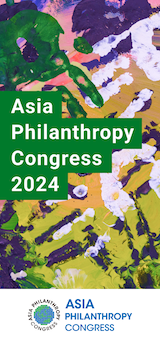The instances where philanthropic capital has built public infrastructure and civic spaces, advocated for and achieved new legislation, or provided services not offered by the state do not always spring readily to mind, but they are vital to the vibrancy and effectiveness of a civil society and third sector we all rely on. This interview series, in partnership with WINGS and Propel Philanthropy, celebrates the funders who are the often unsung heroes of this equitable social impact ecosystem and looks to those of tomorrow.
We showcase funders who have had the far-reaching vision to invest and achieve success in some of our critical issues: from data infrastructure to building local resources, from disaster preparedness to the advocacy we need for a stronger future — and we invite curious funders new to this type of social investment to take their first steps towards funding more and better social impact infrastructure.
 Gayatri Lobo, A T E Chandra Foundation, India
Gayatri Lobo, A T E Chandra Foundation, India
Andrew Milner: The aim of this interview is to get your perspective as funders of infrastructure, but can you start by telling me a little bit about what A T E Chandra Foundation does?
Gayatri Lobo: We are funded by the A T E Group, Mr Amit Chandra and his wife Archana Chandra and when disbursing funds, we look at three things; one is that it has a multiplier effect, two, that we have funding areas that aren’t traditionally funded but require money, and then three, we look to solve problems, so not just an incremental funding year after year, but are we actually solving something. Can we, at the end of a particular period make ourselves redundant? Given we are a family foundation, we don’t have generations of funds, it’s just their current life earnings, and so we want to be very thoughtful about what we fund which is why infrastructure development, or capacity building as we call it, is what we focus on. I would say about 50 per cent of our funding goes there. We also do some work in rural development where we work very specifically on regenerative farming, largely because the current methods of farming which depend heavily on chemicals have resulted in soil degradation, so we focus on trying to help them get out of that. But again, the way we would fund is not directly to a farmer but helping NGOs and government support that transition.
Why have you chosen this route?
Two things; we firmly believe that if you look at, for example, the corporate sector, it’s thriving in India today largely because of the human capital they’ve been able to bring in, the right kind of investments they’ve been able to make either in technology or processes or even just building out new businesses, but that doesn’t exist for the social sector as much as it should. There should be more done in the social sector because of the kind of impact that can be generated as a result. A lot of Indian donors, whether they’re CSR or individuals, prefer focusing on programmatic work. We don’t see that as a sustainable way of work. You can’t solve a problem by making little grants year after year and not focus on actually building an institution.
I don’t think M&E should be seen as a tool to communicate to funders, I think it needs to be seen as a tool to improve your own work.
Tell me about some of the initiatives you’ve had success with. I know you’ve worked with Dasra, you’ve got NGO capacity building programmes, you’ve got Project Tech4dev and Giving Pi. Are those your flagship pieces?
We believe they have all the fundamentals to be able to make deep impact. Tech4dev, for example, has identified the lack of technology as a gap that they want to address. They do that in multiple ways by creating open-source products for NGOs to use. They are building our AI tools, they also then realised that a human gap in technology is a problem, so they have a fractal Chief Technology Officer Programme who can move across NGOs and save them the cost of hiring a CTO.
I would say that one of the successes that we can take some credit for is the investment that we had made along with the Gates Foundation, Omidyar and Veddis Foundation to build out a platform called Give India. They were able to use this combined donation which was around USD 3.6 million and was just pre-pandemic, to think about what kind of investments they need to make in technology, in the right people. So, they hired some high-powered staff to be able to build out Give India as a platform. Before the investment, they were raising about three and a half million dollars. During Covid they raised about USD 120 million in a year, and they were able to raise a lot of funds for NGOs on the ground. Now they have settled at about USD 60 million. That’s a big jump, hence what I would consider a success.
There’s an obvious way of measuring impact for something like that and I know you’re big on impact measurement, so how do you generally go about it where it’s less easy to see?
As you say, with fundraising it’s fairly easy. You can look at before and after the investment. We have actually put out a study to show that for every rupee an NGO invests in fundraising, what does it mean in terms of the return. The lowest return that we saw was about 28 rupees and the highest was as high as 300 rupees, just by focusing on an investment in fundraising.
We also fund people development programmes like ILSS that focuses on building people skills. There’s another programme we had funded, Common Purpose that focuses on building the second rung of leaders in organisations to be able to be future leaders.
That’s a long-term investment, it’s quite difficult to measure. How do you know that’s working?
Two things – one is we’ve funded the NGOs to get third-party assessments themselves, so Common Purpose currently is going to start their third-party evaluation of how impactful their work has been. But we’ve also launched a study of our own; without getting into any specific NGO we look at the entire universe of programmes running in India today to try and understand from those who benefited from the programme, what that benefit was and what are the current gaps they see in the sector. The reason we’re doing this is so we can take it to other donors as well and say, ‘look at the return of investing in human capital’ and for us to identify what’s working, what’s not, and what are the gaps that exist. Should we start looking for programmes in those areas or even talk to some of our existing partners to see if they can expand their work into additional areas?
The co-funders of Give India were all external funders apart from you. Is there anyone else in India doing this kind of thing?
When we think about NGOs, everyone talks about resilience and sustainability, but if I think of them as actual change agents, then I want to deepen the impact that they make.
More recently, yes. We are still known as the ones who do capacity building. We want more people to be known as supporting that, but we do know that the Rohini Nilekani Philanthropies, for example, has recently started a capacity-building vertical. We know that there are a few Indian funders who have now said to grantees you can spend the money on what you want, it doesn’t matter. Three things have triggered this: one, we have started talking a lot about the impact that it’s had on our NGOs. We’ve also said to NGOs, while we will fund you, we want you to bring other funders as well so that our money can be used for something else. For example, if today I’m funding your NGO to build human capital in your organisation, in three years time, I want you to bring somebody else to do that, so I can move on. The third thing that has triggered this is the Foreign Contribution (Regulation) Act (FCRA) in India. That has put a cap on how much of FCRA money can be used for non-programmatic areas in your organisation. I ran an NGO myself a few years ago and I can tell you, at that time this law didn’t exist and I heavily relied on my foreign funders to pay for my capacity building needs. There was no need for me to ask an Indian donor. The minute that pipeline ended, you needed to raise more funds from Indian donors. NowNGOs have started asking more for capacity building and I think they should be asking more.
In bringing in other Indian donors, how important is the work that you do as a kind of ambassador or example?
I think it’s extremely important. Formerly, we felt we should just put our heads down and do the work and it doesn’t matter whether we talk about it or not. It was only a year and a half ago that we actually hired Sharmista [Chaudhury] as a communications person. We didn’t like to talk about our work, but it’s changed so dramatically since then, communications is now a goal for all of our our work at the foundation. So, each of us within our key areas for the year have communication targets. We talk about the model, what works, how this is helping NGOs like the fundraising study I just told you about. The team is now working on converting that into an article that can be posted. We are in the process of actually building out our website for the first time ever, which will have a lot of resources, like case studies that other NGOs and donors can look at and read up and have videos up there. So, it’s going to be a good knowledge and resource centre.
You said earlier that capacity building work tends to be unpopular because people want to see more direct results for their money. What do you wish donors knew about the importance of capacity building?
When we think about NGOs, everyone talks about resilience and sustainability, but if I think of them as actual change agents, then I want to deepen the impact that they make. Our role as funders needs to change to developing an organisation to be a solution provider. There will always be a need for organisations to continue doing their everyday work, so if you’re working with children who have intellectual disabilities, that’s not going to change tomorrow, but there are certain aspects of your work that you can change at scale while you continue working with these children – the hypocrisy, the normalisation of them being in public, the integration of them in schools at different levels of opportunity – and these are things that you can do beyond just the 40, 50 children you’re working with. So, I think we need to see NGOs as levers of change, as clichéd as it sounds. We are not just existing for a day and the next day and the day after.
What kinds of capacity building needs are you seeing?
We focus on six of them: the first being leadership – building the capacity of the leaders in the organisation, strategic clarity, fundraising, HR, we look at communications, and we look at monitoring and evaluation. NGOs may have other needs, too, but given we’re a small foundation, we’ve chosen these.
How do you see the importance of monitoring and evaluation?
I don’t think M&E should be seen as a tool to communicate to funders, I think it needs to be seen as a tool to improve your own work. Some of that can be communicated to your funders, but you need on any particular day to be able to know what’s happening in the programme in Uttar Pradesh, even while sitting in Bombay. If the school has shut down, I need to fix it. This is information that really needs to be at your fingertips. So you have monitoring that continues. The evaluation part can be both for yourself as well as for donors.
The reason we’ve called out M&E is that there are NGOs who rightly put this under programme costs, but there are many who don’t because they see it as outside their programme but it’s integral to what they’re doing.
You’ve worked with Dasra which is one of the few infrastructure organisations in India. Tell me about that work.
With Dasra, we’ve done multiple things. One of them which I talked about earlier was building their leadership development programmes. The second was investing in their idea of being almost like a thinking partner to Indian donors and helping them give more strategically. They’ve now pivoted that into something even bigger which is GivingPi, which again is to help philanthropists connect with each other, give more money, give more strategically, and really look at a thriving donor community.
We’ve also funded another organisation called Accelerate India Philanthropy, it’s fairly new so we’re one of the early co-founders. They have a three-part agenda, so to speak – to get Indians to give more, give sooner, and give better and they’ve already got about 25 Indian philanthropists working with them outside of the co-founders.
What have been the results of the GivingPi so far? Is there a measurable way to say?
I don’t think they’ve started measuring yet. I think right now the focus is on building the network. We sit on the advisory board of Accelerate India Philanthropy, so we have a little more of a ringside view. They get paid a very small amount by each of the philanthropists, which is like a membership, but it shows a little more engagement than a networking event. Recently they did an event in Mumbai where more than 100 people showed up, and they had Boston Consulting Group (BCG) release a report which floated the idea of every ultra high-net worth individual giving five per cent of their wealth and what that would mean for India’s development.
A giving pledge-type idea?
Yes. And then the last thing I would say as an example of platforms for raising funds, is that we’ve worked a lot on the Social Stock Exchange (SSE). Our founder is on the advisory board of the securities board for the Social Stock Exchange, he was also on the drafting committee, and we’ve done a lot of the research that needs to be done among NGOs and among donors. What we’ve also done is fund a few of the NGOs to enable them to list which shows how this entire process works so that more NGOs list. Today there are nine NGOs who have listed 10 projects on the SSE. The first eight amounted to INR 11.3 crores (USD 1.3 million) and the last alone was INR 10 crores (USD 1.2 million). That’s just happened, it’s going to be listed soon. We are also working with another intermediary NGO to develop a guidebook so any NGO that wants to list can now see in a very easy to understand fashion how they can move from registration to listing, and what documents they require at what stage .
Is the SSE taking off as fast as you’d like?
To be honest I was not optimistic, so it’s been faster than I personally thought. If I asked others in the foundation, it’s probably at par with what they expected, but we now need to socialise the idea among retail donors for the next jump. Up to now, it’s been institutional donors who’ve been investing in the stock exchange, but the whole idea of the stock exchange is so that any of us could log in and get involved. We need to do something on the marketing front to build that awareness among retail donors.
When you go to events with your peers or other Indian donors, are you actively trying to spread the idea of funding for capacity building? How do you go about it?
It’s at three levels: one is the research and the writing that we do. The second is the events we speak at and, at the third level, a lot of donors who are just starting out, reach out to us, so we do one-on-one meetings with them, take them through our entire strategy. A lot of the tools we build in-house, we share with others. We worked with an agency on a framework to measure capacity building, which is not necessarily easy, but we built a rubric with them, we’ve tested it out with our NGOs, now we share it far and wide, get feedback from people. So that’s become a platform for everyone to use. Similarly, internally we built a database of vendors for the social sector. We realised that this needs to be out there, so one of our partners, the India Development Review (IDR) put it up on their website so anyone can use it.
Presumably things like Give India are good advertising as well because often there’s a perception that if you invest in something invisible, like capacity building, it’s maybe a lot of money and you get no return from it, but if you can show something like Give India…
Absolutely. You can measure the actual financial return, but we’ve put out some of the less measurable ones through case studies in IDR, who also we fund, talking about how organisations have grown to reach more beneficiaries, or start working with government or spread or deepen their impact just through capacity building grants.
Are you seeing signs of change among the funding community that this idea of funding capacity building is starting to move?
I’m starting to feel hopeful now because I hear different conversations. There’s now an entire conference happening annually only on capacity building, and it’s got funders from outside ATE Chandra Foundation. There are platforms like the Pay What It Takes set up at Bridgespan which encourages NGOs to ask for what it takes, and donors to pay what it takes. So those things give me hope.
This interview is being shared free-to-read as a part of the Propel Philanthropy interview project. In addition to this article series, Propel Philanthropy collects stories demonstrating that modest grants can drive but results. You can learn more here.




Comments (0)